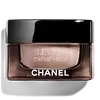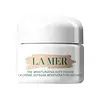What's inside
What's inside
 Key Ingredients
Key Ingredients

 Benefits
Benefits

 Concerns
Concerns

 Ingredients Side-by-side
Ingredients Side-by-side

Water
Skin ConditioningGlycerin
HumectantButylene Glycol
HumectantAluminum Starch Octenylsuccinate
AbsorbentCetearyl Alcohol
EmollientIsododecane
EmollientIsostearyl Neopentanoate
EmollientButyrospermum Parkii Butter
Skin ConditioningPentylene Glycol
Skin ConditioningPEG-8
HumectantOryza Sativa Powder
Squalane
EmollientIpomoea Batatas Root Extract
Skin ConditioningMedicago Sativa Extract
TonicSaccharomyces Cerevisiae Extract
Skin ConditioningCera Alba
EmollientJojoba Esters
EmollientDipropylene Glycol
HumectantGlyceryl Stearate
EmollientPEG-100 Stearate
Sodium Carbomer
Emulsion StabilisingCetearyl Glucoside
EmulsifyingTocopheryl Acetate
AntioxidantChlorphenesin
AntimicrobialHydrolyzed Soy Protein
HumectantCaprylyl Glycol
EmollientPhospholipids
Skin ConditioningSodium Acrylates/C10-30 Alkyl Acrylate Crosspolymer
Escin
TonicPhenoxyethanol
PreservativeSodium Citrate
BufferingBeta-Sitosterol
Emulsion StabilisingBiosaccharide Gum-1
HumectantPolyquaternium-51
Skin ConditioningSodium Polyacrylate
AbsorbentAdenosine
Skin ConditioningSodium Hyaluronate
HumectantPhytic Acid
Polysorbate 20
EmulsifyingEthylhexylglycerin
Skin ConditioningHydrochloric Acid
BufferingTocopherol
AntioxidantPalmitoyl Tripeptide-1
Skin ConditioningPalmitoyl Tetrapeptide-7
Skin ConditioningSodium Benzoate
MaskingCitric Acid
BufferingWater, Glycerin, Butylene Glycol, Aluminum Starch Octenylsuccinate, Cetearyl Alcohol, Isododecane, Isostearyl Neopentanoate, Butyrospermum Parkii Butter, Pentylene Glycol, PEG-8, Oryza Sativa Powder, Squalane, Ipomoea Batatas Root Extract, Medicago Sativa Extract, Saccharomyces Cerevisiae Extract, Cera Alba, Jojoba Esters, Dipropylene Glycol, Glyceryl Stearate, PEG-100 Stearate, Sodium Carbomer, Cetearyl Glucoside, Tocopheryl Acetate, Chlorphenesin, Hydrolyzed Soy Protein, Caprylyl Glycol, Phospholipids, Sodium Acrylates/C10-30 Alkyl Acrylate Crosspolymer, Escin, Phenoxyethanol, Sodium Citrate, Beta-Sitosterol, Biosaccharide Gum-1, Polyquaternium-51, Sodium Polyacrylate, Adenosine, Sodium Hyaluronate, Phytic Acid, Polysorbate 20, Ethylhexylglycerin, Hydrochloric Acid, Tocopherol, Palmitoyl Tripeptide-1, Palmitoyl Tetrapeptide-7, Sodium Benzoate, Citric Acid
Algae Extract
EmollientCyclopentasiloxane
EmollientPetrolatum
EmollientGlyceryl Distearate
EmollientPhenyl Trimethicone
Skin ConditioningCyclohexasiloxane
EmollientButylene Glycol
HumectantCholesterol
EmollientButyrospermum Parkii Butter
Skin ConditioningSteareth-10
EmulsifyingDimethicone
EmollientGlyceryl Stearate Se
EmulsifyingPolysilicone-11
Glyceryl Triacetyl Ricinoleate
EmollientMacadamia Integrifolia Seed Oil
Skin ConditioningGlycerin
HumectantSesamum Indicum Seed Oil
EmollientMedicago Sativa Seed Powder
Skin ConditioningHelianthus Annuus Seedcake
AbrasivePrunus Amygdalus Dulcis Seed Meal
AbrasiveEucalyptus Globulus Leaf Oil
PerfumingSodium Gluconate
Skin ConditioningCopper Gluconate
Skin ConditioningCalcium Gluconate
HumectantMagnesium Gluconate
Skin ConditioningZinc Gluconate
Skin ConditioningTocopheryl Succinate
AntioxidantNiacin
SmoothingSesamum Indicum Seed Powder
Skin ConditioningWater
Skin ConditioningCitrus Aurantifolia Peel Extract
CleansingLaminaria Digitata Extract
Skin ProtectingCrithmum Maritimum Extract
Skin ConditioningSalicornia Herbacea Extract
Skin ConditioningPlankton Extract
Skin ConditioningChlorella Vulgaris Extract
Skin ConditioningRosmarinus Officinalis Leaf Extract
AntimicrobialSodium Hyaluronate
HumectantTocopheryl Acetate
AntioxidantAcetyl Hexapeptide-8
HumectantCaffeine
Skin ConditioningTetrahexyldecyl Ascorbate
AntioxidantPalmitoyl Hexapeptide-12
Skin ConditioningCaprylic/Capric Triglyceride
MaskingTriethylhexanoin
MaskingSodium PCA
HumectantCetyl Alcohol
EmollientDiethylhexyl Succinate
EmollientIsocetyl Stearoyl Stearate
EmollientCyanocobalamin
Skin ConditioningC13-14 Isoparaffin
EmollientDistearyldimonium Chloride
Dipalmitoyl Hydroxyproline
Skin ConditioningSucrose
HumectantHydrogenated Vegetable Oil
EmollientTrehalose
HumectantHydrolyzed Algin
Micrococcus Lysate
Skin ConditioningMaris Sal
Skin ConditioningTetradecyl Aminobutyroylvalylaminobutyric Urea Trifluoroacetate
Skin ConditioningLactoperoxidase
StabilisingGlucose Oxidase
StabilisingUrea
BufferingGlucose
HumectantPolyacrylamide
Glyceryl Polymethacrylate
PEG-8
HumectantLaureth-7
EmulsifyingLecithin
EmollientTriacetin
AntimicrobialSodium Chloride
MaskingPolyquaternium-51
Skin ConditioningPotassium Phosphate
BufferingAlcohol Denat.
AntimicrobialParfum
MaskingLimonene
PerfumingLinalool
PerfumingHydroxycitronellal
PerfumingCitronellol
PerfumingGeraniol
PerfumingBHT
AntioxidantDisodium EDTA
Sorbic Acid
PreservativeChlorphenesin
AntimicrobialPotassium Sorbate
PreservativePhenoxyethanol
PreservativeAlgae Extract, Cyclopentasiloxane, Petrolatum, Glyceryl Distearate, Phenyl Trimethicone, Cyclohexasiloxane, Butylene Glycol, Cholesterol, Butyrospermum Parkii Butter, Steareth-10, Dimethicone, Glyceryl Stearate Se, Polysilicone-11, Glyceryl Triacetyl Ricinoleate, Macadamia Integrifolia Seed Oil, Glycerin, Sesamum Indicum Seed Oil, Medicago Sativa Seed Powder, Helianthus Annuus Seedcake, Prunus Amygdalus Dulcis Seed Meal, Eucalyptus Globulus Leaf Oil, Sodium Gluconate, Copper Gluconate, Calcium Gluconate, Magnesium Gluconate, Zinc Gluconate, Tocopheryl Succinate, Niacin, Sesamum Indicum Seed Powder, Water, Citrus Aurantifolia Peel Extract, Laminaria Digitata Extract, Crithmum Maritimum Extract, Salicornia Herbacea Extract, Plankton Extract, Chlorella Vulgaris Extract, Rosmarinus Officinalis Leaf Extract, Sodium Hyaluronate, Tocopheryl Acetate, Acetyl Hexapeptide-8, Caffeine, Tetrahexyldecyl Ascorbate, Palmitoyl Hexapeptide-12, Caprylic/Capric Triglyceride, Triethylhexanoin, Sodium PCA, Cetyl Alcohol, Diethylhexyl Succinate, Isocetyl Stearoyl Stearate, Cyanocobalamin, C13-14 Isoparaffin, Distearyldimonium Chloride, Dipalmitoyl Hydroxyproline, Sucrose, Hydrogenated Vegetable Oil, Trehalose, Hydrolyzed Algin, Micrococcus Lysate, Maris Sal, Tetradecyl Aminobutyroylvalylaminobutyric Urea Trifluoroacetate, Lactoperoxidase, Glucose Oxidase, Urea, Glucose, Polyacrylamide, Glyceryl Polymethacrylate, PEG-8, Laureth-7, Lecithin, Triacetin, Sodium Chloride, Polyquaternium-51, Potassium Phosphate, Alcohol Denat., Parfum, Limonene, Linalool, Hydroxycitronellal, Citronellol, Geraniol, BHT, Disodium EDTA, Sorbic Acid, Chlorphenesin, Potassium Sorbate, Phenoxyethanol
 Reviews
Reviews

Ingredients Explained
These ingredients are found in both products.
Ingredients higher up in an ingredient list are typically present in a larger amount.
Butylene Glycol (or BG) is used within cosmetic products for a few different reasons:
Overall, Butylene Glycol is a safe and well-rounded ingredient that works well with other ingredients.
Though this ingredient works well with most skin types, some people with sensitive skin may experience a reaction such as allergic rashes, closed comedones, or itchiness.
Learn more about Butylene GlycolThis ingredient is also known as shea butter. It is an effective skin hydrator and emollient.
Emollients help soothe and soften your skin. It does this by creating a protective film on your skin. This barrier helps trap moisture and keeps your skin hydrated. Emollients may be effective at treating dry or itchy skin.
Shea butter is rich in antioxidants. Antioxidants help fight free-radicals, or molecules that may harm the body. It is also full of fatty acids including stearic acid and linoleic acid. These acids help replenish the skin and keep skin moisturized.
While Shea Butter has an SPF rating of about 3-4, it is not a sunscreen replacement.
Shea butter may not be fungal acne safe. We recommend speaking with a professional if you have any concerns.
Learn more about Butyrospermum Parkii ButterChlorphenesin is a synthetic preservative. It helps protect a product against bacteria in order to extend shelf life. In most cases, Chlorphenesin is paired with other preservatives such as phenoxyethanol and caprylyl glycol.
Chlorphenesin is a biocide. This means it is able to help fight the microorganisms on our skin. It is also able to fight odor-releasing bacteria.
Chlorphenesin is soluble in both water and glycerin.
Studies show Chlorphenesin is easily absorbed by our skin. You should speak with a skincare professional if you have concerns about using Chlorphenesin.
Learn more about ChlorphenesinGlycerin is already naturally found in your skin. It helps moisturize and protect your skin.
A study from 2016 found glycerin to be more effective as a humectant than AHAs and hyaluronic acid.
As a humectant, it helps the skin stay hydrated by pulling moisture to your skin. The low molecular weight of glycerin allows it to pull moisture into the deeper layers of your skin.
Hydrated skin improves your skin barrier; Your skin barrier helps protect against irritants and bacteria.
Glycerin has also been found to have antimicrobial and antiviral properties. Due to these properties, glycerin is often used in wound and burn treatments.
In cosmetics, glycerin is usually derived from plants such as soybean or palm. However, it can also be sourced from animals, such as tallow or animal fat.
This ingredient is organic, colorless, odorless, and non-toxic.
Glycerin is the name for this ingredient in American English. British English uses Glycerol/Glycerine.
Learn more about GlycerinPEG-8 is a synthetic polymer used as a humectant and solvent.
This ingredient is able to help dissolve active ingredients, including water. This gives it humectant properties.
It is soluble in water. The number '8' stands for the molecular weight of the ingredient.
Learn more about PEG-8Phenoxyethanol is a preservative that has germicide, antimicrobial, and aromatic properties. Studies show that phenoxyethanol can prevent microbial growth. By itself, it has a scent that is similar to that of a rose.
It's often used in formulations along with Caprylyl Glycol to preserve the shelf life of products.
Polyquaternium-51 is a polymer salt. It helps hydrate the skin by creating a film on top. This film traps moisture in, keeping your skin soft and hydrated.
Sodium Hyaluronate is hyaluronic acid's salt form. It is commonly derived from the sodium salt of hyaluronic acid.
Like hyaluronic acid, it is great at holding water and acts as a humectant. This makes it a great skin hydrating ingredient.
Sodium Hyaluronate is naturally occurring in our bodies and is mostly found in eye fluid and joints.
These are some other common types of Hyaluronic Acid:
Learn more about Sodium HyaluronateTocopheryl Acetate is AKA Vitamin E. It is an antioxidant and protects your skin from free radicals. Free radicals damage the skin by breaking down collagen.
One study found using Tocopheryl Acetate with Vitamin C decreased the number of sunburned cells.
Tocopheryl Acetate is commonly found in both skincare and dietary supplements.
Learn more about Tocopheryl AcetateWater. It's the most common cosmetic ingredient of all. You'll usually see it at the top of ingredient lists, meaning that it makes up the largest part of the product.
So why is it so popular? Water most often acts as a solvent - this means that it helps dissolve other ingredients into the formulation.
You'll also recognize water as that liquid we all need to stay alive. If you see this, drink a glass of water. Stay hydrated!
Learn more about Water